Cost Accounting & Management Control: Pelican Instruments Analysis
VerifiedAdded on 2023/06/15
|7
|1359
|251
Report
AI Summary
This report analyzes the profitability variance of Pelican Instruments, Inc. for the year ended 1997, focusing on the impact of marketing, R&D, and administration expenses. Despite an unfavorable gross margin variance, the company achieved a positive profitability variance, primarily due to favorable variances in marketing and R&D expenses. The analysis includes a detailed breakdown of budget vs. actual figures for sales, cost of goods sold, operating expenses, and profit before taxes. The report also assesses the performance of different managers and departments, suggesting bonus allocations based on their contributions to the company's overall profitability, with emphasis on rewarding positive contributions to profit.
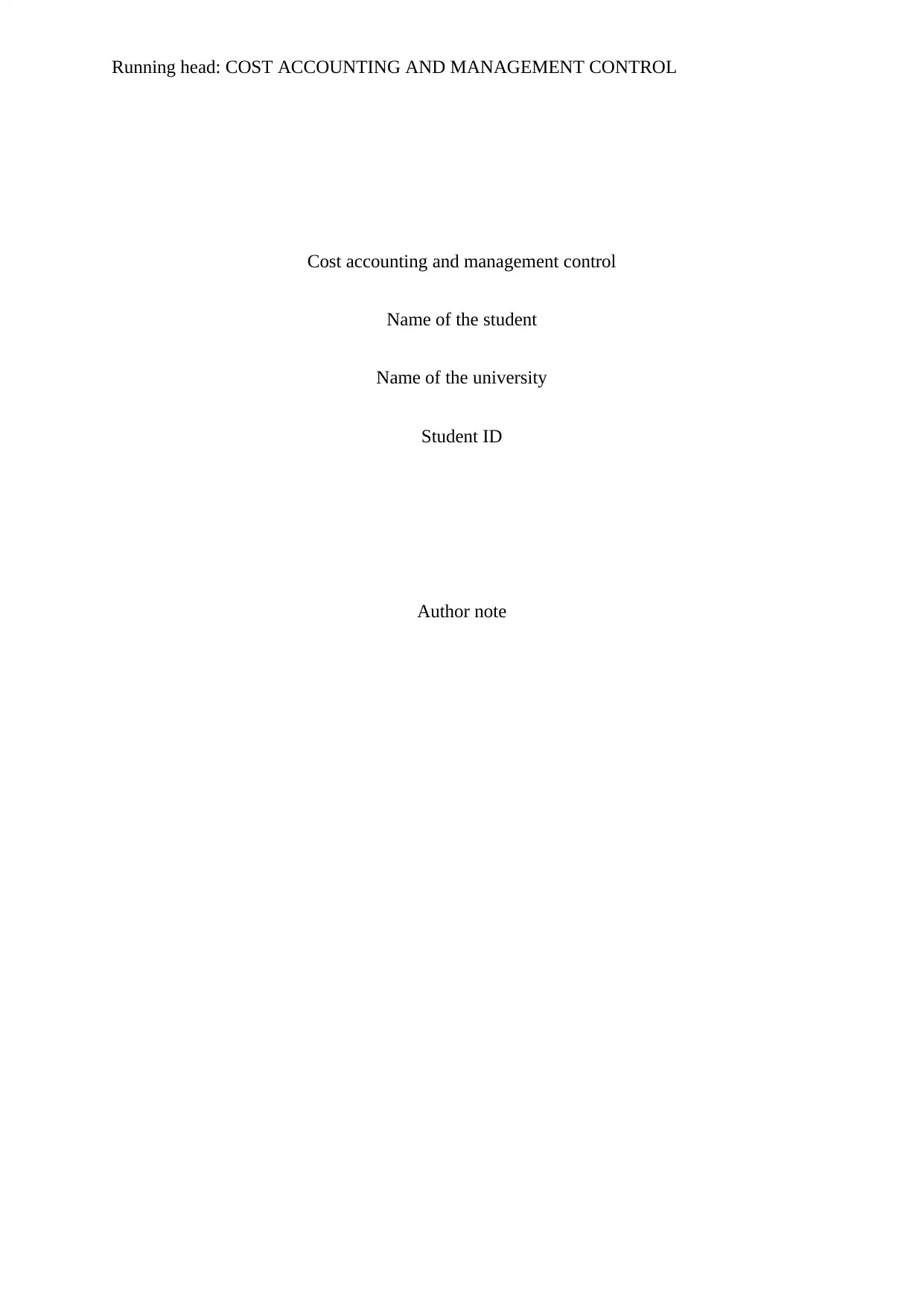
Running head: COST ACCOUNTING AND MANAGEMENT CONTROL
Cost accounting and management control
Name of the student
Name of the university
Student ID
Author note
Cost accounting and management control
Name of the student
Name of the university
Student ID
Author note
Paraphrase This Document
Need a fresh take? Get an instant paraphrase of this document with our AI Paraphraser
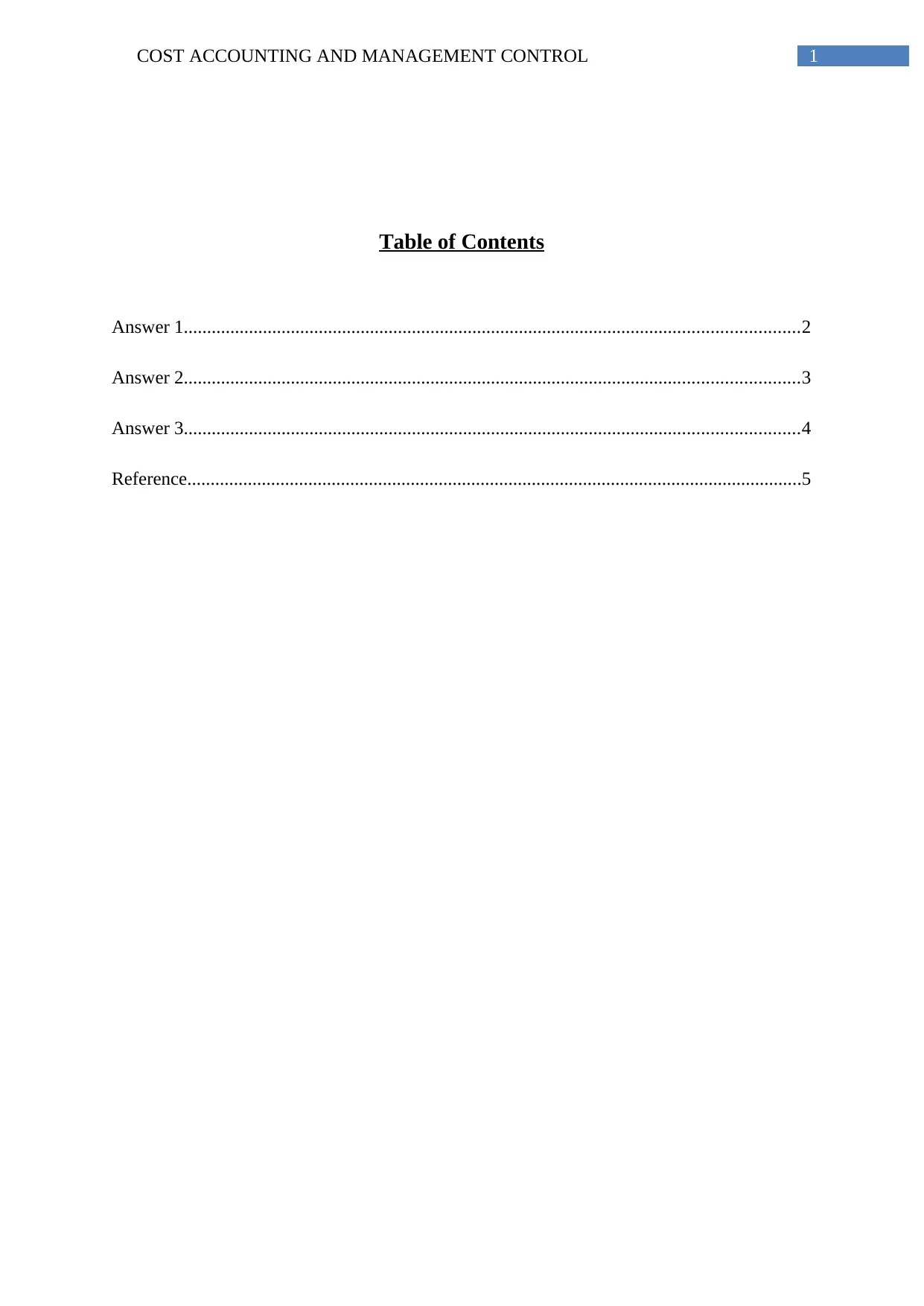
1COST ACCOUNTING AND MANAGEMENT CONTROL
Table of Contents
Answer 1....................................................................................................................................2
Answer 2....................................................................................................................................3
Answer 3....................................................................................................................................4
Reference....................................................................................................................................5
Table of Contents
Answer 1....................................................................................................................................2
Answer 2....................................................................................................................................3
Answer 3....................................................................................................................................4
Reference....................................................................................................................................5

2COST ACCOUNTING AND MANAGEMENT CONTROL
Answer 1
Report –
Introduction – the main objective of this report is to analyse profitability variance of Pelican
Instruments, Inc. for the year ended 1997. The report will focus on the amount of positive
variance caused to the profit owing to the variance of marketing, R & D and administration
expenses (Drury 2013).
Discussion –
Particulars Budget
(‘000)
Actual
(‘000)
Variance
(‘000)
Favourable /
Unfavourable
Sales $16,872.00 $17,061.00 $ 189.00 Favourable
Cost of goods sold $ 9,668.00 $ 9,865.00 $ (197.00) Unfavourable
Gross Margin $ 7,204.00 $ 7,196.00 $ (8.00) Unfavourable
Less: Other operating
expenses
Marketing $ 1,856.00 $ 1,440.00 $ 416.00 Favourable
R & D $ 1,480.00 $ 932.00 $ 548.00 Favourable
Administration $ 1,340.00 $ 1,674.00 $(334.00) Unfavourable
Profit before taxes $ 2,528.00 $ 3,150.00 $ 622.00 Favourable
As per the given data, it is identified that the irrespective of unfavourable gross
margin variance, the company was able to convert the profitability variance into positive one.
The major contribution towards the favourable profit variance is the positive variance of
marketing as well as R & D expenses (Groot and Selto 2013). It is identified that the actual
marketing expenses of the company amounted to $ 1440,000 as against the budget of $
1856,000. On the other hand, the actual R & D expenses of the company amounted to $
932,000 as against the budget of $ 1480,000. However, the administration expenses had
Answer 1
Report –
Introduction – the main objective of this report is to analyse profitability variance of Pelican
Instruments, Inc. for the year ended 1997. The report will focus on the amount of positive
variance caused to the profit owing to the variance of marketing, R & D and administration
expenses (Drury 2013).
Discussion –
Particulars Budget
(‘000)
Actual
(‘000)
Variance
(‘000)
Favourable /
Unfavourable
Sales $16,872.00 $17,061.00 $ 189.00 Favourable
Cost of goods sold $ 9,668.00 $ 9,865.00 $ (197.00) Unfavourable
Gross Margin $ 7,204.00 $ 7,196.00 $ (8.00) Unfavourable
Less: Other operating
expenses
Marketing $ 1,856.00 $ 1,440.00 $ 416.00 Favourable
R & D $ 1,480.00 $ 932.00 $ 548.00 Favourable
Administration $ 1,340.00 $ 1,674.00 $(334.00) Unfavourable
Profit before taxes $ 2,528.00 $ 3,150.00 $ 622.00 Favourable
As per the given data, it is identified that the irrespective of unfavourable gross
margin variance, the company was able to convert the profitability variance into positive one.
The major contribution towards the favourable profit variance is the positive variance of
marketing as well as R & D expenses (Groot and Selto 2013). It is identified that the actual
marketing expenses of the company amounted to $ 1440,000 as against the budget of $
1856,000. On the other hand, the actual R & D expenses of the company amounted to $
932,000 as against the budget of $ 1480,000. However, the administration expenses had
⊘ This is a preview!⊘
Do you want full access?
Subscribe today to unlock all pages.

Trusted by 1+ million students worldwide
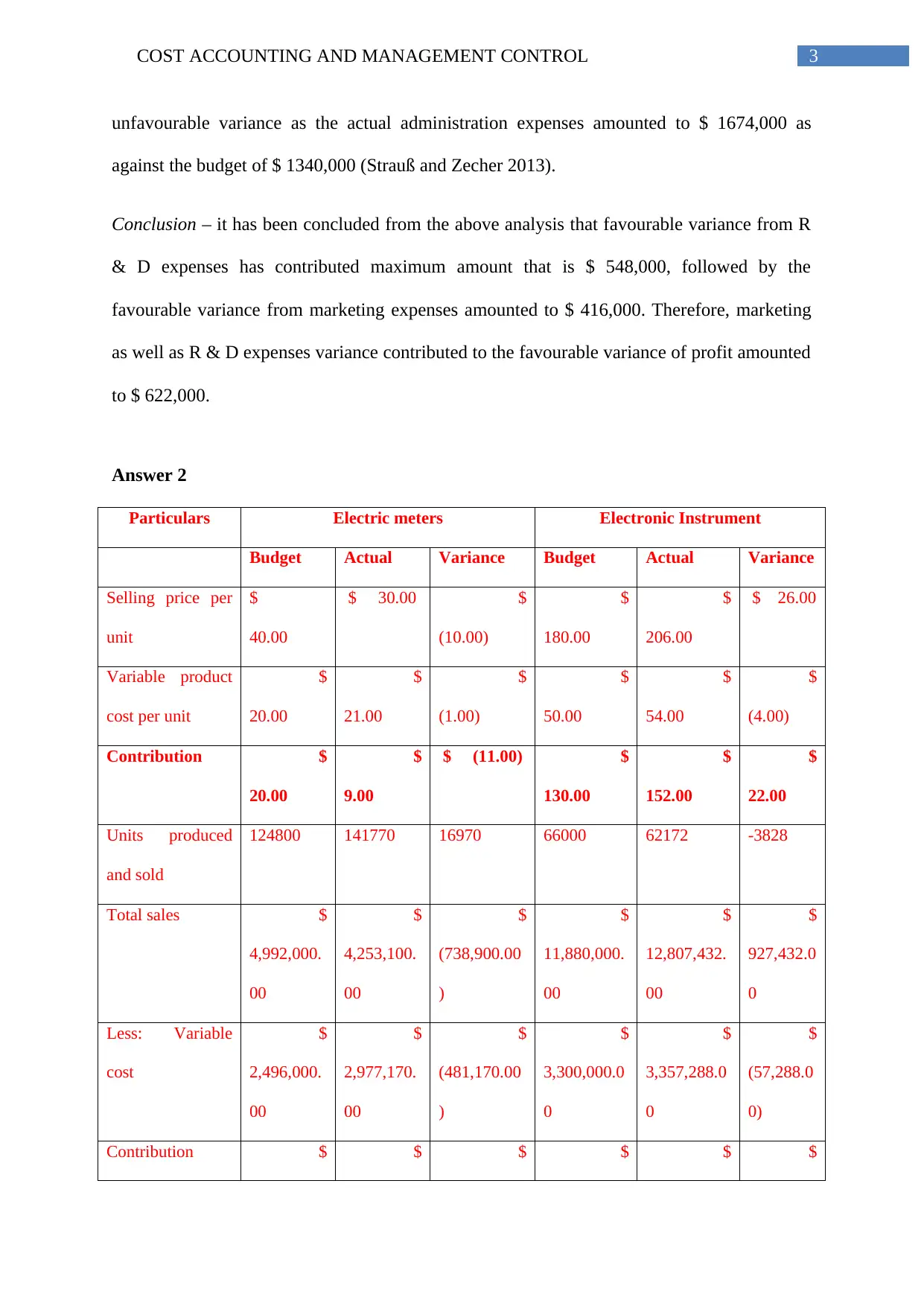
3COST ACCOUNTING AND MANAGEMENT CONTROL
unfavourable variance as the actual administration expenses amounted to $ 1674,000 as
against the budget of $ 1340,000 (Strauß and Zecher 2013).
Conclusion – it has been concluded from the above analysis that favourable variance from R
& D expenses has contributed maximum amount that is $ 548,000, followed by the
favourable variance from marketing expenses amounted to $ 416,000. Therefore, marketing
as well as R & D expenses variance contributed to the favourable variance of profit amounted
to $ 622,000.
Answer 2
Particulars Electric meters Electronic Instrument
Budget Actual Variance Budget Actual Variance
Selling price per
unit
$
40.00
$ 30.00 $
(10.00)
$
180.00
$
206.00
$ 26.00
Variable product
cost per unit
$
20.00
$
21.00
$
(1.00)
$
50.00
$
54.00
$
(4.00)
Contribution $
20.00
$
9.00
$ (11.00) $
130.00
$
152.00
$
22.00
Units produced
and sold
124800 141770 16970 66000 62172 -3828
Total sales $
4,992,000.
00
$
4,253,100.
00
$
(738,900.00
)
$
11,880,000.
00
$
12,807,432.
00
$
927,432.0
0
Less: Variable
cost
$
2,496,000.
00
$
2,977,170.
00
$
(481,170.00
)
$
3,300,000.0
0
$
3,357,288.0
0
$
(57,288.0
0)
Contribution $ $ $ $ $ $
unfavourable variance as the actual administration expenses amounted to $ 1674,000 as
against the budget of $ 1340,000 (Strauß and Zecher 2013).
Conclusion – it has been concluded from the above analysis that favourable variance from R
& D expenses has contributed maximum amount that is $ 548,000, followed by the
favourable variance from marketing expenses amounted to $ 416,000. Therefore, marketing
as well as R & D expenses variance contributed to the favourable variance of profit amounted
to $ 622,000.
Answer 2
Particulars Electric meters Electronic Instrument
Budget Actual Variance Budget Actual Variance
Selling price per
unit
$
40.00
$ 30.00 $
(10.00)
$
180.00
$
206.00
$ 26.00
Variable product
cost per unit
$
20.00
$
21.00
$
(1.00)
$
50.00
$
54.00
$
(4.00)
Contribution $
20.00
$
9.00
$ (11.00) $
130.00
$
152.00
$
22.00
Units produced
and sold
124800 141770 16970 66000 62172 -3828
Total sales $
4,992,000.
00
$
4,253,100.
00
$
(738,900.00
)
$
11,880,000.
00
$
12,807,432.
00
$
927,432.0
0
Less: Variable
cost
$
2,496,000.
00
$
2,977,170.
00
$
(481,170.00
)
$
3,300,000.0
0
$
3,357,288.0
0
$
(57,288.0
0)
Contribution $ $ $ $ $ $
Paraphrase This Document
Need a fresh take? Get an instant paraphrase of this document with our AI Paraphraser
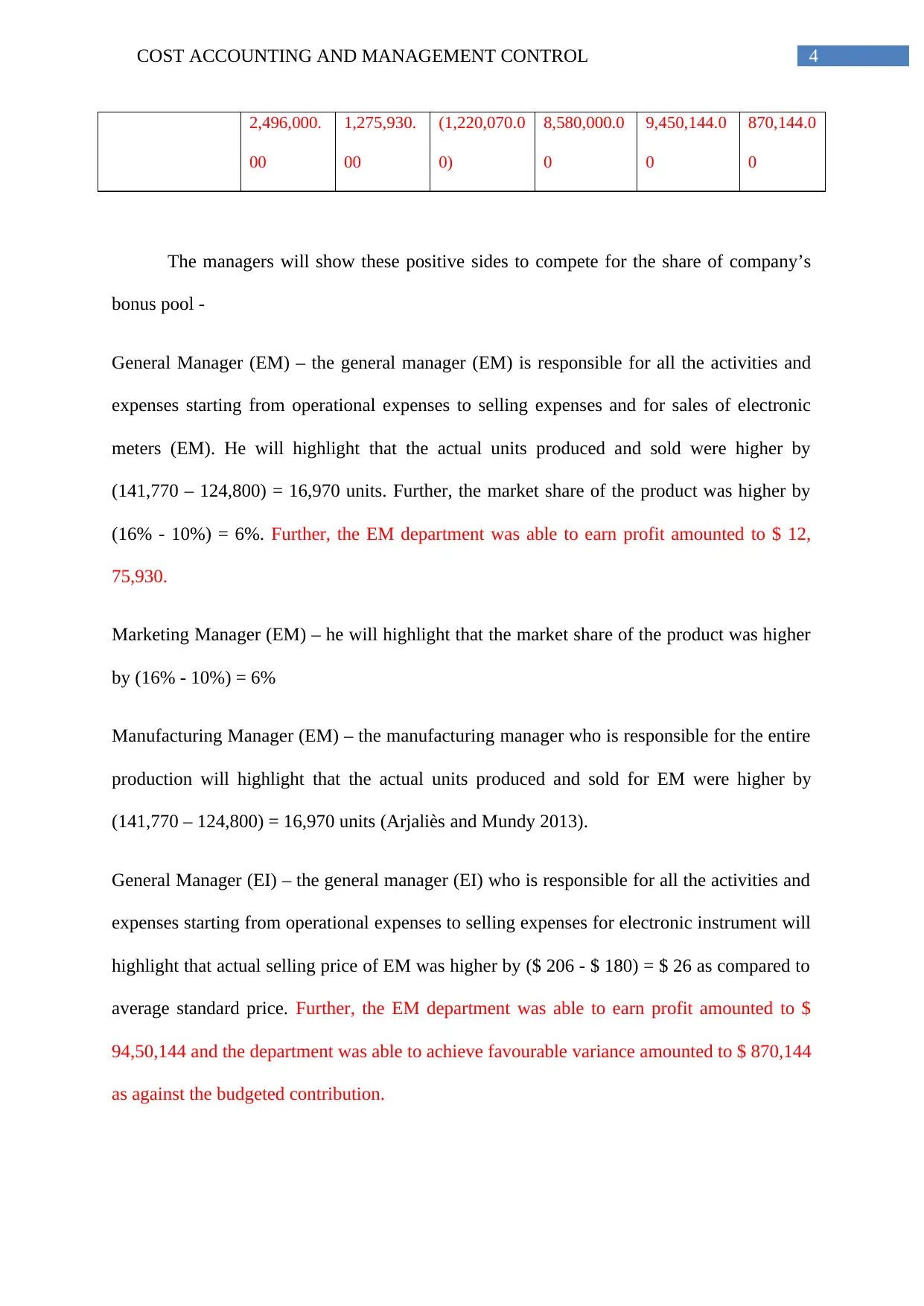
4COST ACCOUNTING AND MANAGEMENT CONTROL
2,496,000.
00
1,275,930.
00
(1,220,070.0
0)
8,580,000.0
0
9,450,144.0
0
870,144.0
0
The managers will show these positive sides to compete for the share of company’s
bonus pool -
General Manager (EM) – the general manager (EM) is responsible for all the activities and
expenses starting from operational expenses to selling expenses and for sales of electronic
meters (EM). He will highlight that the actual units produced and sold were higher by
(141,770 – 124,800) = 16,970 units. Further, the market share of the product was higher by
(16% - 10%) = 6%. Further, the EM department was able to earn profit amounted to $ 12,
75,930.
Marketing Manager (EM) – he will highlight that the market share of the product was higher
by (16% - 10%) = 6%
Manufacturing Manager (EM) – the manufacturing manager who is responsible for the entire
production will highlight that the actual units produced and sold for EM were higher by
(141,770 – 124,800) = 16,970 units (Arjaliès and Mundy 2013).
General Manager (EI) – the general manager (EI) who is responsible for all the activities and
expenses starting from operational expenses to selling expenses for electronic instrument will
highlight that actual selling price of EM was higher by ($ 206 - $ 180) = $ 26 as compared to
average standard price. Further, the EM department was able to earn profit amounted to $
94,50,144 and the department was able to achieve favourable variance amounted to $ 870,144
as against the budgeted contribution.
2,496,000.
00
1,275,930.
00
(1,220,070.0
0)
8,580,000.0
0
9,450,144.0
0
870,144.0
0
The managers will show these positive sides to compete for the share of company’s
bonus pool -
General Manager (EM) – the general manager (EM) is responsible for all the activities and
expenses starting from operational expenses to selling expenses and for sales of electronic
meters (EM). He will highlight that the actual units produced and sold were higher by
(141,770 – 124,800) = 16,970 units. Further, the market share of the product was higher by
(16% - 10%) = 6%. Further, the EM department was able to earn profit amounted to $ 12,
75,930.
Marketing Manager (EM) – he will highlight that the market share of the product was higher
by (16% - 10%) = 6%
Manufacturing Manager (EM) – the manufacturing manager who is responsible for the entire
production will highlight that the actual units produced and sold for EM were higher by
(141,770 – 124,800) = 16,970 units (Arjaliès and Mundy 2013).
General Manager (EI) – the general manager (EI) who is responsible for all the activities and
expenses starting from operational expenses to selling expenses for electronic instrument will
highlight that actual selling price of EM was higher by ($ 206 - $ 180) = $ 26 as compared to
average standard price. Further, the EM department was able to earn profit amounted to $
94,50,144 and the department was able to achieve favourable variance amounted to $ 870,144
as against the budgeted contribution.
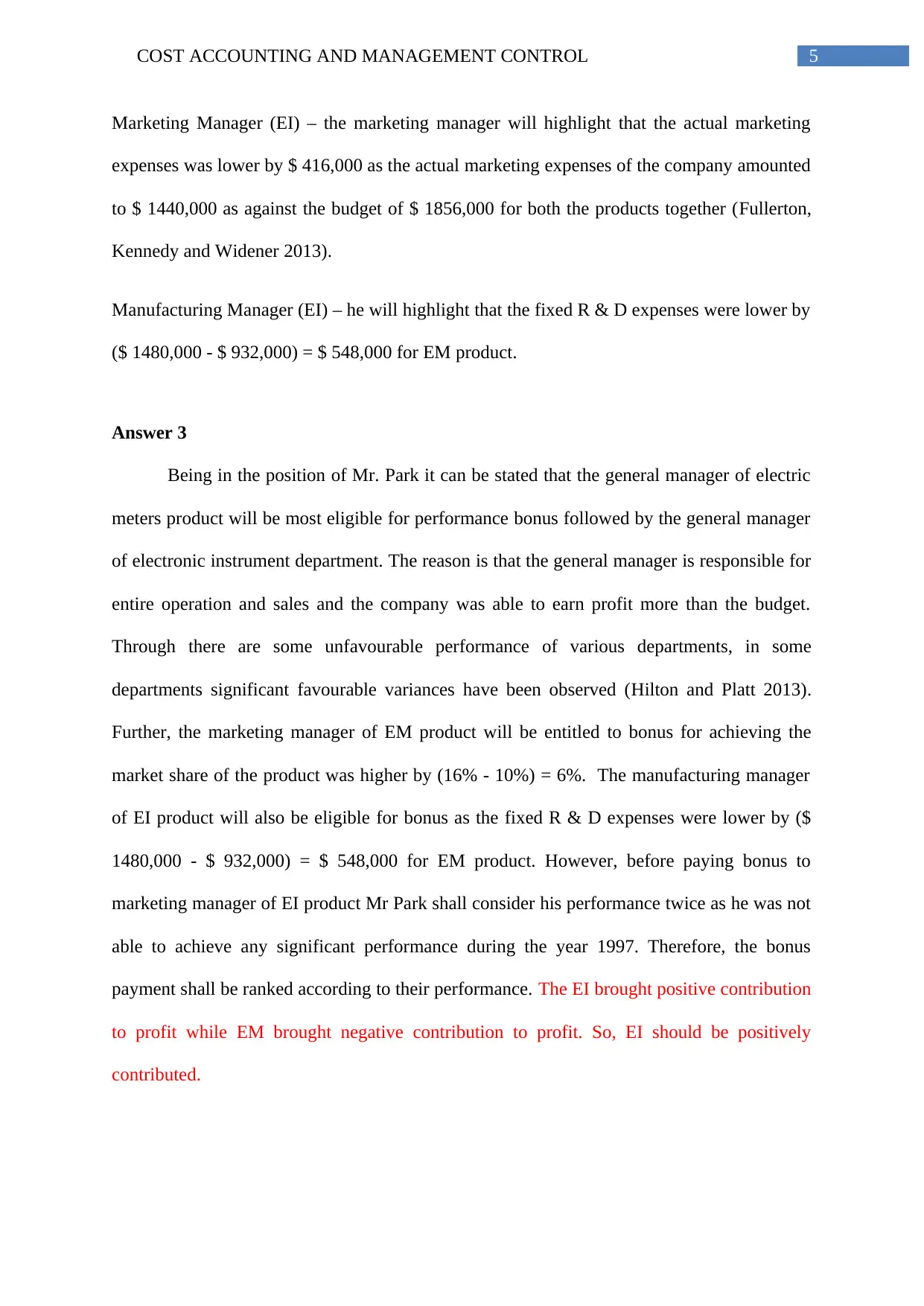
5COST ACCOUNTING AND MANAGEMENT CONTROL
Marketing Manager (EI) – the marketing manager will highlight that the actual marketing
expenses was lower by $ 416,000 as the actual marketing expenses of the company amounted
to $ 1440,000 as against the budget of $ 1856,000 for both the products together (Fullerton,
Kennedy and Widener 2013).
Manufacturing Manager (EI) – he will highlight that the fixed R & D expenses were lower by
($ 1480,000 - $ 932,000) = $ 548,000 for EM product.
Answer 3
Being in the position of Mr. Park it can be stated that the general manager of electric
meters product will be most eligible for performance bonus followed by the general manager
of electronic instrument department. The reason is that the general manager is responsible for
entire operation and sales and the company was able to earn profit more than the budget.
Through there are some unfavourable performance of various departments, in some
departments significant favourable variances have been observed (Hilton and Platt 2013).
Further, the marketing manager of EM product will be entitled to bonus for achieving the
market share of the product was higher by (16% - 10%) = 6%. The manufacturing manager
of EI product will also be eligible for bonus as the fixed R & D expenses were lower by ($
1480,000 - $ 932,000) = $ 548,000 for EM product. However, before paying bonus to
marketing manager of EI product Mr Park shall consider his performance twice as he was not
able to achieve any significant performance during the year 1997. Therefore, the bonus
payment shall be ranked according to their performance. The EI brought positive contribution
to profit while EM brought negative contribution to profit. So, EI should be positively
contributed.
Marketing Manager (EI) – the marketing manager will highlight that the actual marketing
expenses was lower by $ 416,000 as the actual marketing expenses of the company amounted
to $ 1440,000 as against the budget of $ 1856,000 for both the products together (Fullerton,
Kennedy and Widener 2013).
Manufacturing Manager (EI) – he will highlight that the fixed R & D expenses were lower by
($ 1480,000 - $ 932,000) = $ 548,000 for EM product.
Answer 3
Being in the position of Mr. Park it can be stated that the general manager of electric
meters product will be most eligible for performance bonus followed by the general manager
of electronic instrument department. The reason is that the general manager is responsible for
entire operation and sales and the company was able to earn profit more than the budget.
Through there are some unfavourable performance of various departments, in some
departments significant favourable variances have been observed (Hilton and Platt 2013).
Further, the marketing manager of EM product will be entitled to bonus for achieving the
market share of the product was higher by (16% - 10%) = 6%. The manufacturing manager
of EI product will also be eligible for bonus as the fixed R & D expenses were lower by ($
1480,000 - $ 932,000) = $ 548,000 for EM product. However, before paying bonus to
marketing manager of EI product Mr Park shall consider his performance twice as he was not
able to achieve any significant performance during the year 1997. Therefore, the bonus
payment shall be ranked according to their performance. The EI brought positive contribution
to profit while EM brought negative contribution to profit. So, EI should be positively
contributed.
⊘ This is a preview!⊘
Do you want full access?
Subscribe today to unlock all pages.

Trusted by 1+ million students worldwide
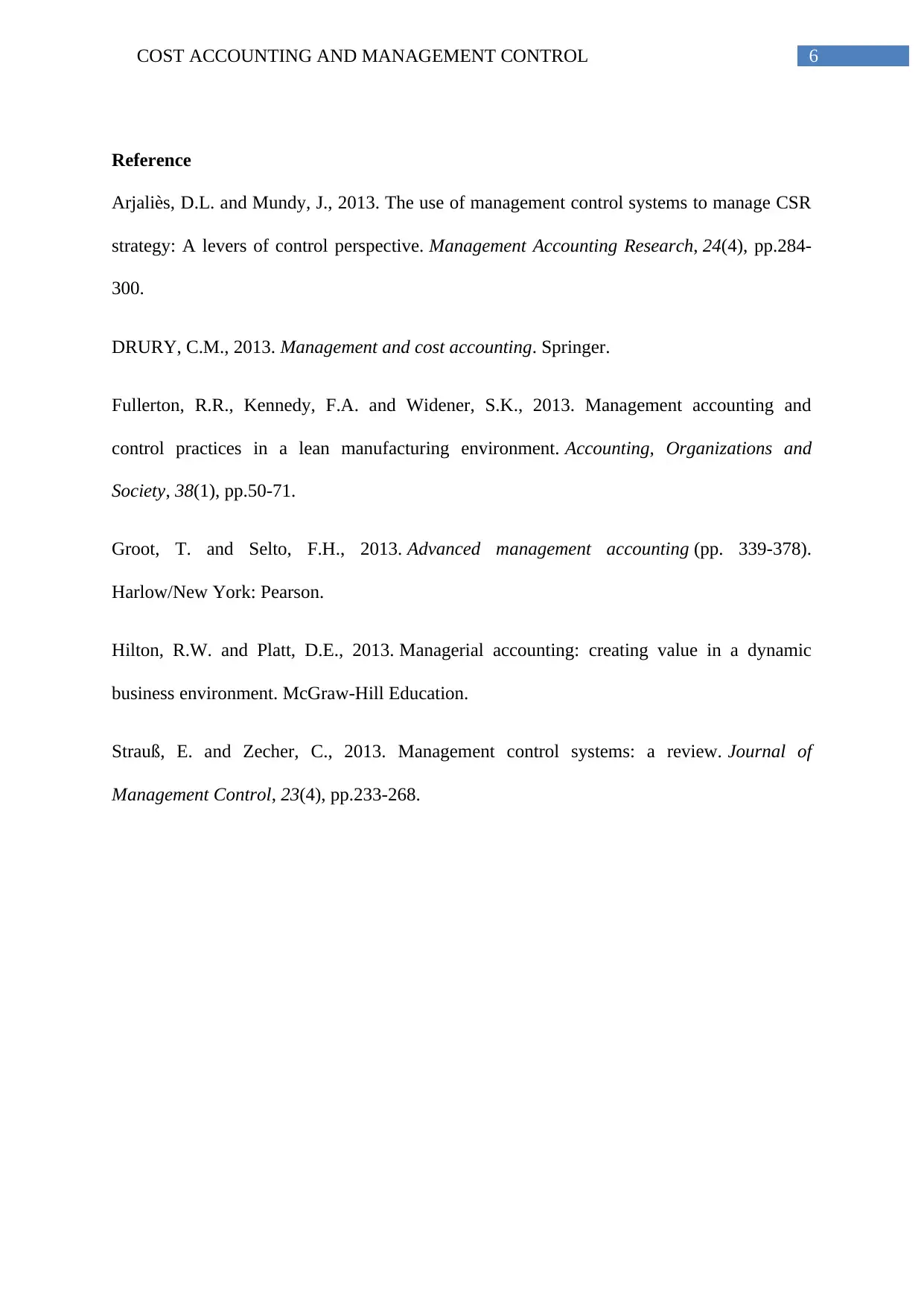
6COST ACCOUNTING AND MANAGEMENT CONTROL
Reference
Arjaliès, D.L. and Mundy, J., 2013. The use of management control systems to manage CSR
strategy: A levers of control perspective. Management Accounting Research, 24(4), pp.284-
300.
DRURY, C.M., 2013. Management and cost accounting. Springer.
Fullerton, R.R., Kennedy, F.A. and Widener, S.K., 2013. Management accounting and
control practices in a lean manufacturing environment. Accounting, Organizations and
Society, 38(1), pp.50-71.
Groot, T. and Selto, F.H., 2013. Advanced management accounting (pp. 339-378).
Harlow/New York: Pearson.
Hilton, R.W. and Platt, D.E., 2013. Managerial accounting: creating value in a dynamic
business environment. McGraw-Hill Education.
Strauß, E. and Zecher, C., 2013. Management control systems: a review. Journal of
Management Control, 23(4), pp.233-268.
Reference
Arjaliès, D.L. and Mundy, J., 2013. The use of management control systems to manage CSR
strategy: A levers of control perspective. Management Accounting Research, 24(4), pp.284-
300.
DRURY, C.M., 2013. Management and cost accounting. Springer.
Fullerton, R.R., Kennedy, F.A. and Widener, S.K., 2013. Management accounting and
control practices in a lean manufacturing environment. Accounting, Organizations and
Society, 38(1), pp.50-71.
Groot, T. and Selto, F.H., 2013. Advanced management accounting (pp. 339-378).
Harlow/New York: Pearson.
Hilton, R.W. and Platt, D.E., 2013. Managerial accounting: creating value in a dynamic
business environment. McGraw-Hill Education.
Strauß, E. and Zecher, C., 2013. Management control systems: a review. Journal of
Management Control, 23(4), pp.233-268.
1 out of 7
Related Documents
Your All-in-One AI-Powered Toolkit for Academic Success.
+13062052269
info@desklib.com
Available 24*7 on WhatsApp / Email
![[object Object]](/_next/static/media/star-bottom.7253800d.svg)
Unlock your academic potential
Copyright © 2020–2025 A2Z Services. All Rights Reserved. Developed and managed by ZUCOL.




